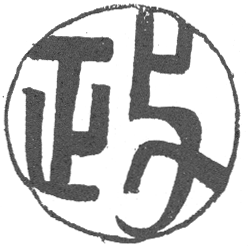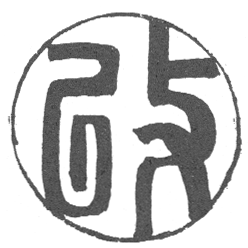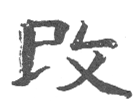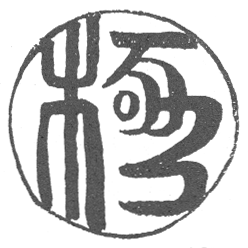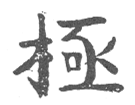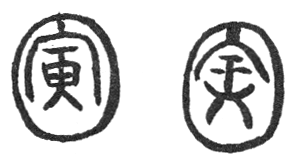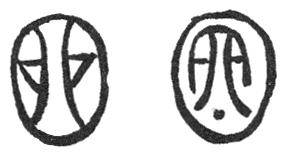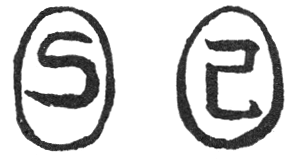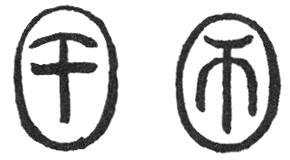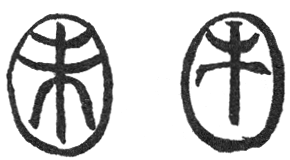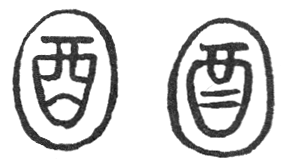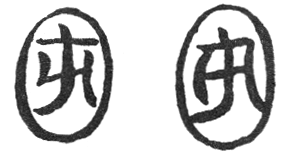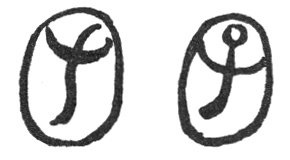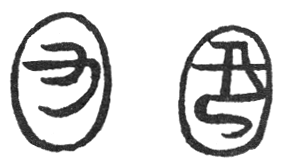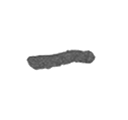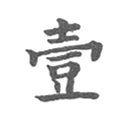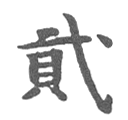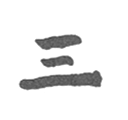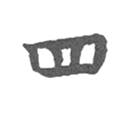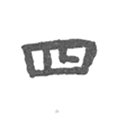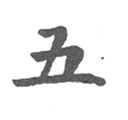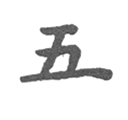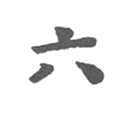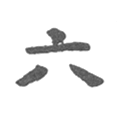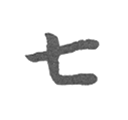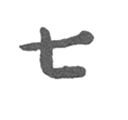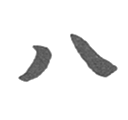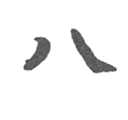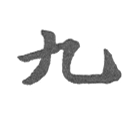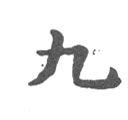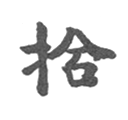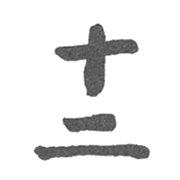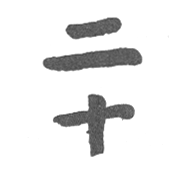APPENDIX 1: THE DATING OF JAPANESE PRINTS
AS the dating of prints is a matter of interest and importance to the collector and student, it will not be out of place to preface the subject by a few words on Japanese chronology.
The longest Japanese unit of time is a cycle of sixty years, which is subdivided into shorter cycles of twelve years; to each year is assigned the name of an animal in regular sequence, similar to our twelve signs of the zodiac.
In addition to these regular divisions, there are also various periods (Nengo) which date from some particular event, such as a great earthquake, an epidemic, or other visitation, and are purely arbitrary in length, a change being often made because of ill-luck. To this is due their frequency previous to the Meiji (enlightened
) period, which dates from 1868 down to the death of the late Emperor in 1911, the present period, Taisho, commencing in 1912. The Meiji period, therefore, was a comparatively long one, and in marked contrast to the Manyen and Ganji periods, which only lasted one year each, for 1860 and 1864; or the Kiowa period of two years, 1802-3.
Other long periods were the Genroku, 1688-1703, sixteen years, and the Kioho, 1716-1735, twenty years.
The same animals which denote the years are also assigned to the hours of the day, which is divided into twelve periods of two hours each.
These twelve animals, the signs for which are reproduced at page 338, are:-; Rat (1), Ox (2), Tiger (3), Hare or Rabbit (4), Dragon (5), Snake (6), Horse (7), Sheep, Ram, or Goat (8), Monkey (9), Cock (10), Dog (11), and Boar (12), the numbers in brackets being the years in the sixty-year cycle, which begins with the Rat, this order being repeated five times through each cycle.
When they represent the hours of the day the sequence begins with the Ox (1 a.m. to 3 a.m.) round to the Rat (11 p.m. to 1 a.m.).
In the date-seal on a print the month is denoted by a number, the year itself by one of the zodiacal signs. Sometimes a cypher for the particular period within which the year falls is also added, which enables us to fix the exact date, unless the period is over twelve years in extent, in which case some of the signs will be repeated. Between 1800 and 1868, however (and date-seals earlier than 1800 are very rarely found), only two periods, Bunkwa (1804-1817, fourteen years) and Tempo (1830-1843, fourteen years), lasted sufficiently long to do this. Thus Tiger year, Tempo period, may be either the equivalent of 1830 or 1842 ; to decide which we must refer to other evidence, if it can be found, such as the years within which the artist worked, the style and quality of the print, form of the date-seal, and so forth.
When the activity of an artist extended over a long period, as was the case with Hokusai for example, the exact dating from the seal alone, apart from other evidence, becomes difficult, when only the year is indicated. Thus Hokusai's two well-known large Chushingura series are both seal- dated for the Tiger year, one issue for the 4th month and the other for the 6th, which is equivalent to 1806, 1818, and 1830, according to the period, Bunkwa, Bunsei, or Tempo, within which it fell. In this instance 1806 is the correct year, as, apart from other evidence, after 1814 the practice of seal-dating appears to have been dropped, not coming into use again till the last year or two of the Prohibition period, about 1850. After this it was practically universal in one form or another.
Many prints will be found dated between 1800 and 1810, such as examples by Utamaro and his pupils (thus helping to distinguish between work by Utamaro II and his master), by Yeizan, and by Toyokuni, and other artists of this period. Amongst prints illustrated in this volume are the following bearing date-seals between these years : Shunko, 1807 (Plate 2) ; Yeizan, 1808 (Plate 4, Illustration 2); Yeizan, 1806 (Plate C), and 1807 (Plate 33).
At the end of this appendix, on page 336, are reproduced on an enlarged scale three seals with their corresponding cyphers, two of which, Nos. 2 and 3, are often found on prints. Seal No. 1, which is the seal for the Ansei period, does not, however, occur on prints, but is given here to show the difference between it and the aratamè seal (No. 2) with which it may be confused, owing to their similarity.
This aratamè seal is an inspector's seal meaning examined,
and prints carrying this seal are sometimes wrongly described as being seal-dated for the Ansei period, whereas it only signifies they have passed the censor. Many of the upright prints by Hiroshige bear the aratamè seal, and it is only a coincidence that they are also sometimes dated for a year lying within the Ansei period (1854-59), such as those from the Hundred Views in Yedo
series.
The aratamè seal, it should be noted, came into use in this form towards the close of the year 1853, when the censors' seals began to be discontinued, and its appearance probably denoted that the duty of censoring prints devolved upon the publisher himself. (See Hiroshige's upright Tokaido series, which has the oval date-seal for the year 1855, and also the round aratamè seal.)
Sometimes, it will be noticed, the date-seal, such as that on the print illustrated at Plate 20 (No. 4), page 136, carries a small cypher in addition to the zodiacal sign and the numeral of the month. This is the uru cypher and denotes an intercalary or additional month, certain years having thirteen months. As no two years of the same sign in any one period have an intercalary month, a date-seal of this nature can be definitely determined. In the above instance the seal reads Tiger uru seven,
that is, intercalary seventh month, Tiger year
= 1854 (Ansei period), as the previous Tiger year which had an intercalary month (the third) was 1830 (Tempo period), the Tiger year for 1842 (also Tempo period) having no intercalary month.
Also the evidence of the aratamè seal above the date-seal places the date as later than 1852, thus giving corroborative evidence as to correctness of date in this instance.
As another example of the uru cypher in a date-seal we will instance Plate 63 of Hiroshige's Hundred Views in Yedo
series, showing a great paper carp flying from a bamboo pole on the boys' birthday festival. This plate is dated snake uru five
= intercalary fifth month, Snake year
(= 1857); no other Snake year has an intercalary month.
Plate 107, showing a great eagle hovering in the sky (illustrated at Plate 28A, page 174) also has this date-seal with the uru cypher in it.
In the table of Japanese dates on page 337, the years having intercalary months are marked by a †, followed by the number of the month in brackets.
Series of prints, such as Hiroshige's Sixty Odd Provinces,
which extended from the Prohibition period till after its close, will be found with certain plates bearing the censors' seals and others with only the aratamè seal, in conjunction with the date-seal.
After 1857 the aratamè seal disappears for a year (for what reason is not known), and only the date-seal is found, as is shown in Hiroshige's Thirty-six Views of Fuji
series (upright), and his Mountain and Sea as Wrestlers
series (oblong) ; both these have the seal for the Horse year (1858) only. (See Plates 16 and 21.) Kunisada's well-known memorial portrait of Hiroshige also confirms this. (See also print by Shigenobu [Hiroshige II] at Plate 7, Illustration 3.)
In the Ram (or Goat) year, 1859, and subsequently, the aratamè seal reappears, but is now incorporated with the date in a single round seal. (See prints by Hiroshige II at Plates 27 and 29.)
The Prohibition period, the nature of which we have already stated earlier in this volume, extended from the sixth month of 1842 to the close of 1853. Prints issued during these eleven and a half years had to carry a censor's seal before they could be issued to the public, and fines, including confiscation of the offending print, were levied for any infraction of this regulation.
These seals, of which twelve are known, are generally found in pairs, and less frequently singly. Hiroshige's two series (upright) of historical and dramatic subjects described and illustrated in Chapter XXXIV, show in one set, two seals, and in the other one only. They will be noticed in other prints herein illustrated.
As far as our investigations go, these censors' seals appeared alone without a date-seal till about the year 1850, after which the oval date-seal occurs alongside them, the earliest so far noted being for the Rat year (1852). After the last month or two of 1853, as mentioned above, the censors' seals disappear, their place being taken by the aratamè seal, while the date-seal is continued.
This transition can be seen in Hiroshige's extensive series of Yedo Meisho
view's (oblong), published by Yamadaya between 1853 and 1858, and known for distinction as the Yamadaya figure set. Prints in it dated Ox 11 (11th month, 1853) have two censors' seals, so apparently the censorship was not discontinued till either the very end of the 11th month or early in the twelfth. Prints dated 1854 and later have the aratamè seal instead.
As many censored prints have no date thereon, we may assume therefore that, lacking other evidence, these appeared between 1842 and 1850, and are earlier than the dated examples.
To sum up the foregoing remarks on date-seals we may set out the following facts respecting them.
A date-seal and a censor's seal occurring together enables us to fix the date exactly, as we know the years in which prints were censored.
Thus the date Ox 9 with a censor's seal gives the year 1853, ninth month, because the previous Ox year (1841) would require no censor's seal, and the following one, 1865, would also have no censor's seal, but would be incorporated with the aratamè seal.
If a seal has the uru (intercalary) cypher in it, this alone, apart from the presence or otherwise of any other seal, will fix the exact date. Thus, Snake uru five
must be 1857, as no other Snake year for the same period has an intercalary month ; no two years of the same zodiacal sign in any one period have an intercalary month. As, however, only two periods since 1800, Bunkwa and Tempo, down to 1868, duplicate any of the signs, the need for this distinction rarely occurs.
If a date-seal occurs in company with the aratamè seal, we know the date must lie between the end of 1853 and the end of 1857, this being the period for such combination.
In the same way when the two are found combined together in one round seal, we can fix the date as from the beginning of 1859 onwards.
Sometimes a date-seal may carry no zodiacal sign, but only the uru cypher and the number of the month; we can determine the exact date by applying one of the above tests. To make this clear we will select two years within the above period, 1854 to 1868, in which the same month was intercalary, viz. 1857 and 1865; in both these years the fifth month was intercalary.
The date-seal for 5th month, 1857 (which falls in the Ansei period, zodiacal sign Snake), would be uru five,
accompanied by the aratamè seal; for the same month of 1865 (Kei-o period, Ox sign) it would be incorporated with the aratamè seal.
The year 1846 also has the same month intercalary, in which case the date uru five
would be accompanied by a censor's seal, but as date- seals do not appear to have been used so early in the censored period, this combination would not be met with.
Aratamè when written in characters may also be translated changing to,
as when an artist is on the point of adopting another name and signs himself (for example) Kunisada aratamè ni sei Toyokuni, Kunisada changing (his name) to the second Toyokuni.
Seal No. 3 occurs frequently on prints and reads kiwamè, meaning perfect.
It has no connection with the censor, but was affixed by the publisher himself to prints only of a certain merit. It was, therefore, intended as a kind of hall-mark; but as the art of the colour-printer fell into decay towards the middle of last century, it became customary to put it on every print issued, so that it eventually lost its significance as the mark of a good print.
On page 337 is given a comparative table of Japanese Chronology for the period during which date-seals were used on prints. As this method of dating prints does not go back earlier than the beginning of the nineteenth century (instances earlier than this are exceedingly rare, and only one, a print in the British Museum, previous to 1802 has come under the writer's notice, though the Yeizan print here illustrated at Plate 4(1) may be cypher-dated 1799, but is difficult to transcribe), it has not been thought necessary to give dates earlier than the year 1800. A full table of comparative dates from 1688 onwards is given in Strange's Handbook to the Collection in the Victoria and Albert Museum, and also in the Catalogue of the British Museum collection.
